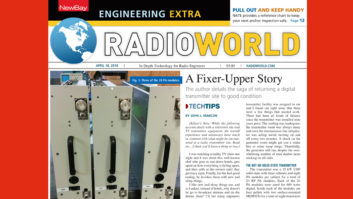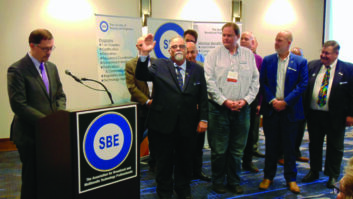[Editor’s Note: While the following account deals with a television site and TV transmitter equipment, the overall experience and takeaways have much in common with what might be encountered at a radio transmitter site. Read on … I think you’ll learn a thing or two.]
I was watching a reality TV show one night and it was about this well-known chef who goes to run-down hotels, gets upset on how everything is falling apart, and then yells at the owners until they get teary eyed. Finally, for the feel-good ending, he lavishes them with new and shiny things.
I like new and shiny things too, and so I asked, instead of hotels, why doesn’t he go to broadcast stations and do the drama there? I’ll bet many engineers would like a makeover on their broadcast techno-world as well.
For now, however, it is up to the engineers to find the solutions to the problems at their sites, which is what this article is all about. In my case, it was not one problem but a number of interrelated issues. It doesn’t have the tears and yelling, but it did have a bit of drama.
About two years ago, a digital TV transmitter facility was assigned to me and I found out right away that there were a few things that needed work. There had been all kinds of failures since the transmitter was installed nine years prior. The cooling was inadequate, the transmitter room was always dusty and even the transmission line dehydrator was acting weird, turning on and off every two minutes. A check on the generator room might get you a snake bite or some wasp stings. Thankfully, the generator still ran, despite the overwhelming number of mud dauber nests sticking on all sides.
THE NOT-SO-SOLID-STATE TRANSMITTER
The transmitter was a 15 kW UHF solid-state with three cabinets and eight PA modules per cabinet for a total of 24 RF PA modules. Each of the 24 PA modules were rated for 660 watts digital. Inside each of the modules are four pallets with two surface-mounted MOSFETs for a total of eight transistors per module.

The first thing I found out was that the output power meter was not reading right. Normally, the cumulative output of the PA modules should be equal or at least close to the transmitter output, but this was not the case with the transmitter. With an Agilent E4418B RF power meter, I calibrated the transmitter meter to read correctly. However, the output of the modules had to be raised to match the reading of the corrected power meter.
This brings us to the second issue, which was about raising the power output of the modules. Because of the higher-than-normal flange temperature of some amplifiers, raising the power would shut them down. Apparently, when the switch from analog to digital happened in 2008, they also changed the transmitter from liquid-cooled to air-cooled solid-state. The air conditioning units were OK for the liquid-cooled transmitter but insufficient for the air-cooled solid-state.
After much planning and work, the air conditioner was upgraded to a higher capacity, and we also added a better air filtering system. This improved the cooling of the modules.
There was almost no usable tool or equipment for fixing the modules, so I had to order new soldering and de-soldering tools, torque screwdrivers, a good magnifier and other necessary equipment for the job. An electronics repair corner inside the building had to be built for more efficient work.
While working on the modules, I also found out that the heat transfer compound (the white stuff between the heat sink and the FET) had dried out and needed to be replaced. At that point, I realized that all 24 modules may have thermal compound issues as well, and that warned of more impending MOSFET failures. The decision to choose which module to check for thermal compound condition was not easy because these are SOT540A surface-mounted MOSFET packages. Great care must be taken in removing the MOSFETs and mounting new ones.
There were MOSFETs with burnt terminals, but after cleaning and re-soldering, some of them worked again. Unfortunately, because of the prolonged high temps, some of the MOSFETs could not be saved and needed replacements.
Availability of the MOSFETs was the next problem because these are obsolete parts. As many of us would do, after looking at the usual electronics parts vendors like Digikey and Mouser and finding nothing, I looked on eBay and indeed found the MOSFETs, but I had some doubts that these parts were genuine. I decided to try a few, and after soldering them on the amps, nothing worked.
In a static test, they appeared to be real MOSFETs. I actually cut open one and the insides looked real. However, when the gate-to-drain and gate-to-source capacitance was measured, the values were markedly different compared to the original transistors. These were definitely unusable.
Fortunately, after a more diligent search on the web, a colleague found a supplier of the genuine article and we were able to replace all the bad MOSFETs.
Some amplifier electrolytic capacitors failed as well, and this happened randomly. Upon studying the published MTBFs of the capacitors and considering the prolonged high temperature they experienced, it turned out that the capacitors on the pallets were already at the end of their life span. I decided to replace all the electrolytic caps on all 24 power modules with a higher MTBF rating for an even longer life. From then on, there were no more overheating failures.
CONTROL SYSTEM AND EXCITERS
The transmitter was designed with SCADA and serial communication for the control system. SCADA stands for “Supervisory Control and Data Acquisition.” This is a system commonly found in large industrial infrastructure like oil refineries, water treatment plants, electrical grids and the like.
The system was fine until one of the controller modules went bad. The control display went blank and the controller was reducing the power of the transmitter for no apparent reason. It took some time before we discovered that the problem was one of the two controllers and not the SCADA. I replaced that controller and everything went back to normal.
The exciter was another story. The transmitter had a dual exciter and a dual-driver amplifier. The manufacturer loaded the exciter with many features. It can display the 8VSB channel spectrum (for the all-important shoulder attenuation), constellation diagram, eye pattern and many other parameters.
After a few years of use, the display system failed because the motherboard running it also failed and this also made the control buttons unusable. This meant having no way to adjust anything from the front panel of the exciter. We needed to at least adjust the power output of the exciter or driver for emergency and maintenance purpose.
The control for each of the subsystems was actually run by a microcontroller, and there was one for each power module. Upon analyzing the terminals of the driver microcontroller, I found out that there were two I/O terminals that can be used to adjust the driver output. This was done by momentarily connecting the designated terminals to ground.
That was all that could be done when the display was not working. The good thing with the design of this exciter was that the RF board was still functional even when the computer failed, and this feature kept us on air.
Our company used the same brand and model of exciters for all the other transmitter sites and had already accumulated nearly $10,000 for repairs of the front panel control and display. But there was no guarantee that the display would not die again after it was fixed. Instead of spending even more money for repair, we decided to get a new exciter for this transmitter. Usually, an exciter is easy to replace, but in this situation, it was made harder because of the proprietary design of the driver system.
When the driver system was designed, it was done in such a way that it was difficult to replace the exciter with one from a different manufacturer. The block diagram of the driver system is shown in Fig. 2. The exciter/modulator output is IF (intermediate frequency) and not RF. All current exciters have RF as output and not IF.

The next issue was the serial communication. The exciter sends a signal to the controller so that the controller knows that the exciter is functioning properly. Hence, a way should be made for the replacement exciter to communicate back to the controller.
Upon learning more about the controller-exciter communication, I discovered that the controller actually shuts down the driver amplifier and not the exciter whenever a fault occurred. As a feedback, the controller senses the presence of the driver output and not the exciter output. The exciter was always left running, even when there was a fault.
I started searching for a compatible exciter, and there were a few reputable manufacturers to choose from. After some asking around, checking the specs and the price, I chose the PT3060 exciter from ProTelevision. This is a company based in Denmark and has decades of experience building this type of equipment. They also provide modulators for OEMs. The specs of the exciter are great, and I liked the web interface as well. The tech support was really helpful during the test and installation phase. Right now, it is in ATSC 1.0, but it can also be software upgraded to ATSC 3.0.

Before we bought the exciter, we got a chance to test a loaner unit with the transmitter. The loaner unit from the local dealer was an older model, but the functionalities were similar with the latest model. It did work on the RF side, but the serial communication could not be done. But as I mentioned earlier, this was not a problem with the controller.
I consulted with the transmitter manufacturer about the project. The service manager said that the exciter should be able work with the transmitter. We then scheduled a site visit by the service manager for the exciter installation and also to check on the other issues with the transmitter. The installation went well, and the exciter performed as expected.
One other thing that I did was to add an external blower for the exciter so it was kept cooler all the time. With the new exciter, some of the transmitter performance measurements were as follows: MER = 33.9 dB; upper and lower shoulder attenuation are –48.3dB and –48.8 dB respectively, and PAPR = 5.7 dB.

HEAVY AND HOT POWER SUPPLY
In this era, switching power supplies are used in most electronic equipment. A quick Google search and one can actually find DC switching power supplies as large as 90 kW. It is highly efficient, reliable and light weight.
However, this transmitter still used the conventional AC to DC power supply for its PA modules: three-phase transformer, three-diode pairs and a bunch of filter capacitors. There are two DC power supplies for each cabinet: one for the top four modules and one for the bottom four. A cabinet is rated 5 kW of RF, and thus four modules account for 2.5 kW RF power. At 20 percent PA efficiency, each DC power supply must provide at least 13 kW of DC power. With a 32V MOSFET drain voltage, the total DC current per power supply is at least 406 amps. This very high current required thick secondary windings on the step-down transformer.
One day, a transmitter low-power alarm went off because a power supply was intermittent. I found out that lower modules of cabinet 1 were shutting down, and it smelled like something was burned. When I opened the power supply, I was horrified to see that one of the three Powerex LD410860 800V/600A diode pairs was badly burned. I discovered later that the bolt connector was loose. To my surprise, the other two screws were also loose but did not burn.

I used 10 mm diameter bolts to fasten the transformer cables to the diodes. The loose bolt and part of the diode melted because of the heat. Fortunately, the 480V transformer was ok and I just had to replace the diode pair and the cable. I got a piece of welding cable and a big crimping tool to attach the lug terminal. As a precaution, I tightened all the screws of all the other power supplies to prevent the same thing happening again. It was a good thing the whole cabinet did not burn down.
To control the DC output, a 480VAC three-phase SCR controller was used at the input of the transformers. The SCR controllers sometimes fail, and this would knock out four modules.
If a module failed, the remaining power is determined using the formula:

This equation was derived from the use of hybrid combiners like the one shown in Fig. 6. On the drawing, as long as PA1 and PA2 have the same level and are 90 degrees apart, P equals the sum of the two inputs. Once any of the input is lost, the P will get half of the remaining input and the other half will go to the 50-ohm resistor. That means a loss of one input reduces the power output to 25 percent.

For example, let us say PA1 = 50W, 0° and PA2 = 50W, 90°. P is equal to 2 x 50W or 100W. If PA2 is out, the 50 watts from PA1 will split between P and the 50-ohm resistor. P will then be reduced from 100W to 25W, which is a 75 percent reduction.
For a 24 power module transmitter, a loss of four modules (or one power supply) reduces power from 100 percent to 69 percent. The legal low power limit is 80 percent and it was a must, therefore, that the power supply be quickly fixed or replaced.

PRESSURIZATION ISSUES
The dehydrator at the site supplies dry, pressurized air to the 6-inch rigid line and three microwave waveguides. As mentioned in the introduction, it was weirdly turning on and off every two minutes, and apparently little or nothing had been done about it. There was surely a leak somewhere in the lines or in the dehydrator itself. I also noticed that one of the tubes going into the manifold was not fitted properly. It seemed that the size of the air manifold adapter did not match the tube size, but a quick spray of soapy water showed that there was no leak in the termination of the tube.
The lines were all OK so I figured that the leak may be coming from inside the dehydrator itself. I found out that the internal filter canister was leaking air, and it could not be fixed. It was therefore decided to purchase a new dehydrator unit.
While this was all happening, there was also an ongoing microwave dish project with a new waveguide. With this additional waveguide, we decided to replace the old manifold and mount the lines properly because they were all over the place.

GENERATOR ROOM INFESTATION
The site had a 300 kW generator located at the west side of the building. There was no operational problem with it except that the room was full of wasp nests, mud dauber nests and occasionally it was also a favorite “hotel room” for snakes. This happened because all the windows and the large roll-up door were left wide open. They decided to leave them open because of the large volume of air that the generator needs.
This room needs to be clean and clear not only for the sake of the machinery, but for operator safety as well. I asked around what could be done about this, and a contractor suggested using perforated aluminum sheets to cover the openings. The perforation holes would allow fresh air in but would stop the insects and snakes. However, there must be enough perforation holes to allow the required volume of fresh air for the generator. I consulted the generator maintenance contractor about this and came up with a large enough sheet size to meet the designed need of fresh air. Since then, the generator room has been clean and safe as well.

SECURITY LIGHTS
A remote site with inadequate lighting is not a good place to work. Not only was it unsafe, but it also added to the inefficiency of doing outdoor jobs. At this site, the building perimeter had utility pole lights on the north and west sides, but nothing on the east and south sides. The south side was also where the tower is located.
It seems to be a trivial matter to install security lights, but the concrete walls of the building were 15 feet high and there was also an additional work of installing the AC lines to power the lights.
We had used wall pack lamps at one of our sites, and we liked the reliability and aesthetics of these lamps. They can be installed high on the wall and still make the surrounding area well lit.
Incidentally, one of our engineers was told that the local electric utility company was replacing all their wall pack lamps. They wanted to get rid of the old lamps and they were given to our engineer at no cost. The fixtures were still in good condition, and we just had to replace the bulbs. We installed three of them on the south and east side. They make for a great combination with the security cameras.
It was no easy task to work on each problem because there was a lot of study, consultation and discussions required before making any decision. The company already had experience with spending money for projects that did not work, so it was important to deliver the goods, so to speak.

As engineers, we like to do things that challenge our skills. At times, we would be at our wit’s end trying to find a solution, but an idea from other tech guys would open our minds to something else that would lead to the right solution. Good old teamwork is always a winner, especially when you’re dealing with a fixer-upper transmitter site.
John L. Marcon, CBTE CBRE, is an 8-VSB specialist and recently worked as acting chief engineer of Victory Television Network (VTN) in Little Rock, Ark. He has 27 years’ experience with radio and TV broadcast transmitters and other equipment, and is also a former vocational electronics teacher. He is an SBE-certified radio and television broadcast engineer who holds a bachelor’s degree in electronics and communications engineering.
Do you have a fixer-upper story to share? Email rwee@nbmedia.com.







